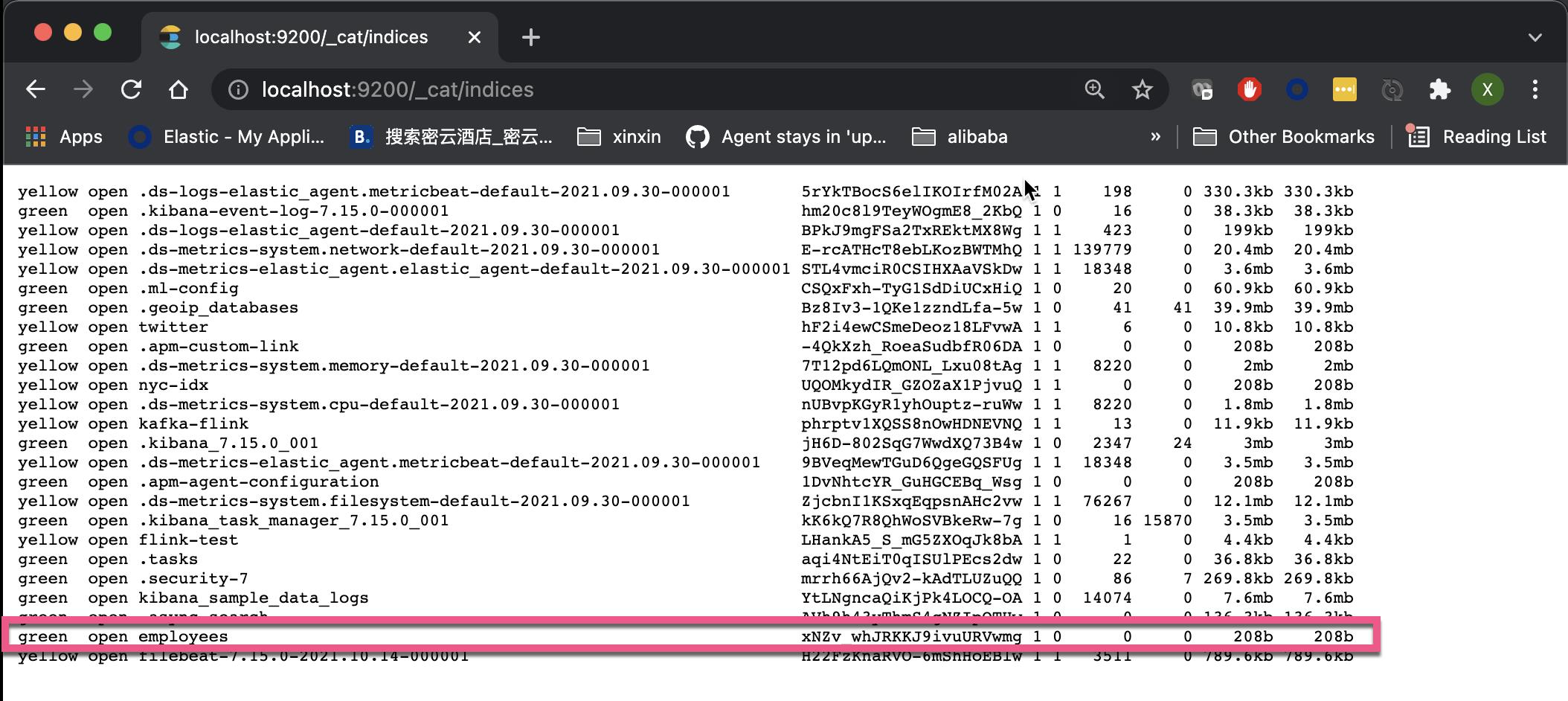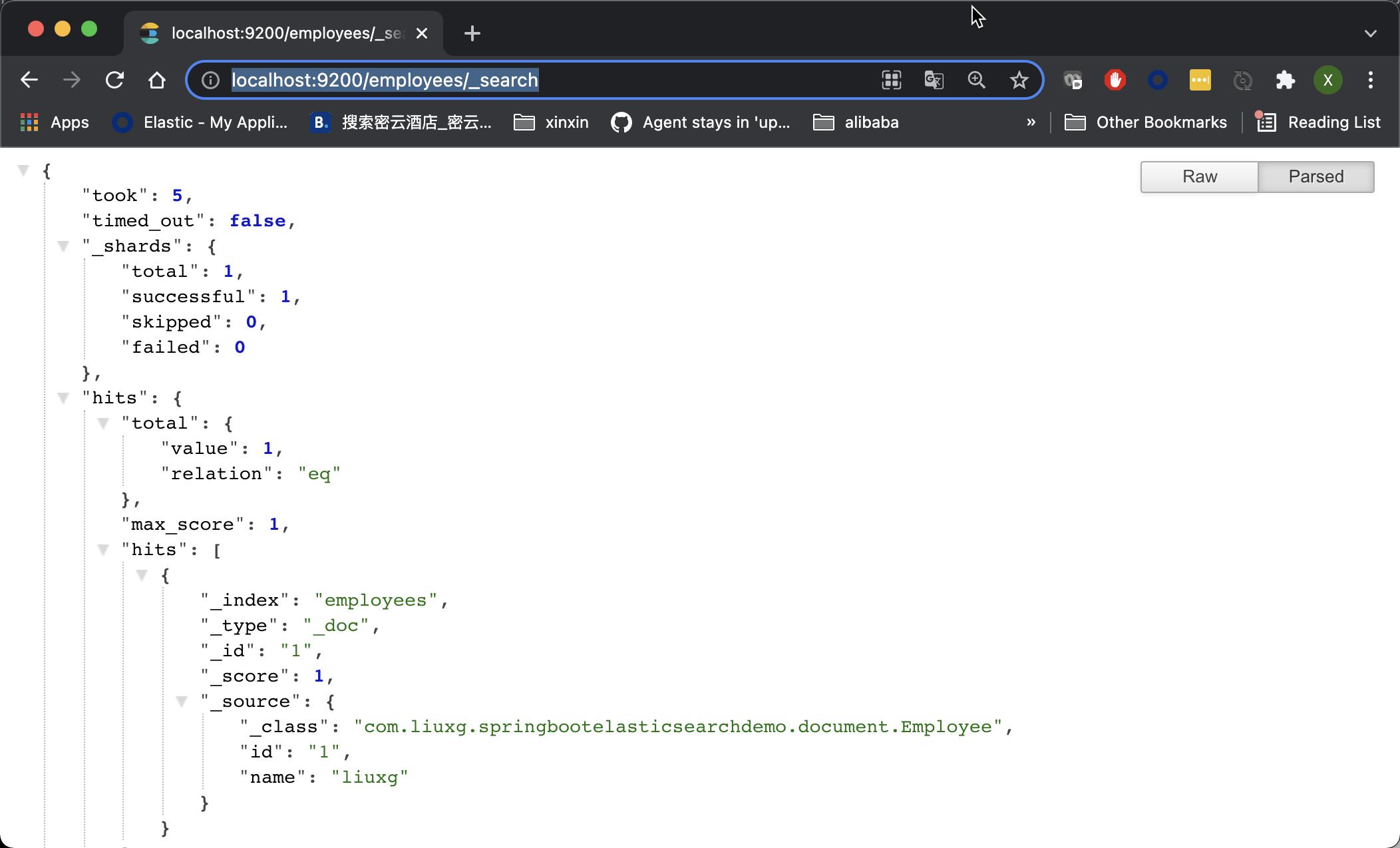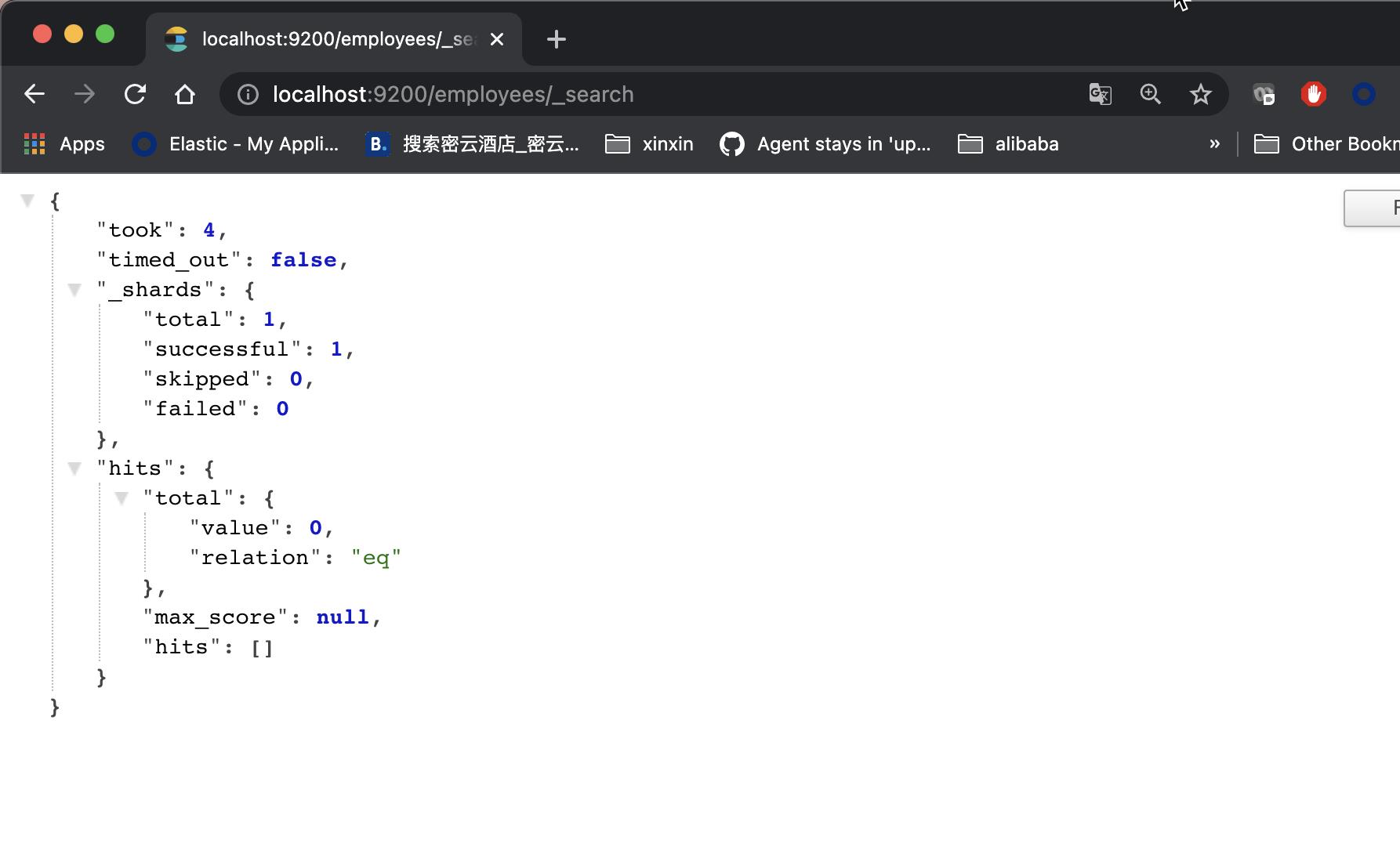Elasticsearch:从 Spring Boot 应用中连接 Elasticsearch
Posted 中国社区官方博客
tags:
篇首语:本文由小常识网(cha138.com)小编为大家整理,主要介绍了Elasticsearch:从 Spring Boot 应用中连接 Elasticsearch相关的知识,希望对你有一定的参考价值。
在之前的文章 “Elasticsearch:通过 Spring Boot 创建 REST APIs 来访问 Elasticsearch”,我详细描述了如何在 Spring Boot 应用中使用 elasticsearch-rest-high-level-client 库来和 Elasticsearch 来进行连接。在今天的文章中,我将使用另外一个库 spring-boot-starter-data-elasticsearch 来和 Elasticsearch 进行连接。这种方法非常简单直接。
为了方便大家阅读,我把最终的代码放到 github GitHub - liu-xiao-guo/SpringBootElasticsearch-demo。你可以使用如下的方式来获得:
git clone https://github.com/liu-xiao-guo/SpringBootElasticsearch-demo代码解释
pom.xml
<?xml version="1.0" encoding="UTF-8"?>
<project xmlns="http://maven.apache.org/POM/4.0.0" xmlns:xsi="http://www.w3.org/2001/XMLSchema-instance"
xsi:schemaLocation="http://maven.apache.org/POM/4.0.0 https://maven.apache.org/xsd/maven-4.0.0.xsd">
<modelVersion>4.0.0</modelVersion>
<parent>
<groupId>org.springframework.boot</groupId>
<artifactId>spring-boot-starter-parent</artifactId>
<version>2.5.5</version>
<relativePath/> <!-- lookup parent from repository -->
</parent>
<groupId>com.liuxg</groupId>
<artifactId>SpringBootElasticsearch-demo</artifactId>
<version>0.0.1-SNAPSHOT</version>
<name>SpringBootElasticsearch-demo</name>
<description>SpringBootElasticsearch-demo</description>
<properties>
<java.version>1.8</java.version>
<elastic.version>7.15.0</elastic.version>
</properties>
<dependencies>
<dependency>
<groupId>org.springframework.boot</groupId>
<artifactId>spring-boot-starter-thymeleaf</artifactId>
</dependency>
<dependency>
<groupId>org.springframework.boot</groupId>
<artifactId>spring-boot-starter-web</artifactId>
</dependency>
<dependency>
<groupId>org.springframework.boot</groupId>
<artifactId>spring-boot-devtools</artifactId>
<scope>runtime</scope>
<optional>true</optional>
</dependency>
<dependency>
<groupId>org.projectlombok</groupId>
<artifactId>lombok</artifactId>
<optional>true</optional>
</dependency>
<dependency>
<groupId>org.springframework.boot</groupId>
<artifactId>spring-boot-starter-test</artifactId>
<scope>test</scope>
</dependency>
<dependency>
<groupId>org.springframework.boot</groupId>
<artifactId>spring-boot-configuration-processor</artifactId>
<optional>true</optional>
</dependency>
<dependency>
<groupId>org.springframework.boot</groupId>
<artifactId>spring-boot-starter-data-elasticsearch</artifactId>
</dependency>
<dependency>
<groupId>org.elasticsearch.client</groupId>
<artifactId>elasticsearch-rest-high-level-client</artifactId>
<version>${elastic.version}</version>
</dependency>
<dependency>
<groupId>org.elasticsearch.client</groupId>
<artifactId>elasticsearch-rest-client</artifactId>
<version>${elastic.version}</version>
</dependency>
<dependency>
<groupId>org.elasticsearch</groupId>
<artifactId>elasticsearch</artifactId>
<version>${elastic.version}</version><!--$NO-MVN-MAN-VER$-->
</dependency>
</dependencies>
<build>
<plugins>
<plugin>
<groupId>org.springframework.boot</groupId>
<artifactId>spring-boot-maven-plugin</artifactId>
<configuration>
<excludes>
<exclude>
<groupId>org.projectlombok</groupId>
<artifactId>lombok</artifactId>
</exclude>
</excludes>
</configuration>
</plugin>
</plugins>
</build>
</project>在上面,请注意我们需要 dependency spring-boot-starter-data-elasticsearch。在我的 Elasticsearch 的集群中,我启动了 Basic 安全认证。超级用户 elastic 的密码设置为 password。在应用中,我们有通过 RestHighLevelClient 来进行鉴权,所以,我也把 elasticsearch-rest-high-level-client 引入进来了。
配置文件
由于默认的端口地址 8080 和我的电脑的端口有冲突,我使用了 9999 端口。另外,我们也可以配置 Elasticsearch 的地址及端口,同时我们也定义了超级用户 elastic 的密码 password:
application.properties
server.port = 9999
elasticsearch.url=localhost:9200
elasticsearch.username=elastic
elasticsearch.password=passworddocument
Employee.java
package com.liuxg.springbootelasticsearchdemo.document;
import org.springframework.data.annotation.Id;
import org.springframework.data.elasticsearch.annotations.Document;
import org.springframework.data.elasticsearch.annotations.Field;
import org.springframework.data.elasticsearch.annotations.FieldType;
@Document(indexName = "employees", shards = 1, replicas = 0, refreshInterval = "5s")
public class Employee {
@Id
@Field(type = FieldType.Keyword)
private String id;
@Field(type = FieldType.Text)
private String name;
public String getId() {
return id;
}
public String getName() {
return name;
}
public void setId(String id) {
this.id = id;
}
public void setName(String name) {
this.name = name;
}
}在上面,我们定义了索引的名称 employees。它里面含有两个字段 id 及 name。它们的属性分别是 keyword 及 text。 当我们运行 Spring Boot 应用时,它将会在 Elasticsearch 中自动帮我们生产 employees 这个索引。
Repository
EmployeeRepository.java
import com.liuxg.springbootelasticsearchdemo.document.Employee;
import org.springframework.data.elasticsearch.annotations.Query;
import org.springframework.data.elasticsearch.repository.ElasticsearchRepository;
import java.util.List;
public interface EmployeeRepository extends ElasticsearchRepository<Employee, String> {
List<Employee> findAllByName(String name);
@Query("{\\"match\\":{\\"name\\":\\"?0\\"}}")
List<Employee> findAllByNameUsingAnnotations(String name);
}在这里,我们定了如何访问 Elasticsearch。其中 ElasticsearchRepository 里含有许多已经设计好的方法可以供我们使用。
Service
EmployeeService.java
package com.liuxg.springbootelasticsearchdemo.service;
import com.liuxg.springbootelasticsearchdemo.document.Employee;
import com.liuxg.springbootelasticsearchdemo.repository.EmployeeRepository;
import org.springframework.beans.factory.annotation.Autowired;
import org.springframework.stereotype.Service;
import java.util.List;
@Service
public class EmployeeService {
private final EmployeeRepository repository;
@Autowired
public EmployeeService(EmployeeRepository repository) {
this.repository = repository;
}
public void save(final Employee employee) { repository.save(employee); }
public Employee findById(final String id) { return repository.findById(id).orElse(null); }
public List<Employee> findByName(final String name) { return repository.findAllByName(name);}
public List<Employee> getEmployeesByNameUsingAnnotation(String name) {
return repository.findAllByNameUsingAnnotations(name);
}
public void deleteEmployee(String id) {
repository.deleteById(id);
}
}Controller
EmployeeController.java
package com.liuxg.springbootelasticsearchdemo.controller;
import com.liuxg.springbootelasticsearchdemo.document.Employee;
import com.liuxg.springbootelasticsearchdemo.service.EmployeeService;
import org.springframework.beans.factory.annotation.Autowired;
import org.springframework.web.bind.annotation.*;
import java.util.List;
@RestController
@RequestMapping("/api/employee")
public class EmployeeController {
private final EmployeeService service;
@Autowired
public EmployeeController(EmployeeService service) {
this.service = service;
}
@PostMapping
public void save(@RequestBody final Employee employee) {
service.save(employee);
}
@GetMapping("/{id}")
public Employee findById(@PathVariable final String id) {
return service.findById(id);
}
@DeleteMapping("/{id}")
public boolean deleteById(@PathVariable String id) {
service.deleteEmployee(id);
return true;
}
@GetMapping("/name/{name}")
public List<Employee> findAllByName(@PathVariable String name) {
return service.findByName(name);
}
@GetMapping("/name/{name}/annotations")
public List<Employee> findAllByNameAnnotations(@PathVariable String name) {
return service.getEmployeesByNameUsingAnnotation(name);
}
}这里定义了一些 REST 接口以方便我们访问 Elasticsearch。
Configuration
Config.java
package com.liuxg.springbootelasticsearchdemo.configuration;
import lombok.RequiredArgsConstructor;
import org.elasticsearch.client.RestHighLevelClient;
import org.springframework.beans.factory.annotation.Value;
import org.springframework.context.annotation.Bean;
import org.springframework.context.annotation.ComponentScan;
import org.springframework.context.annotation.Configuration;
import org.springframework.data.elasticsearch.client.ClientConfiguration;
import org.springframework.data.elasticsearch.client.RestClients;
import org.springframework.data.elasticsearch.config.AbstractElasticsearchConfiguration;
import org.springframework.data.elasticsearch.repository.config.EnableElasticsearchRepositories;
@Configuration
@EnableElasticsearchRepositories(basePackages = "com.liuxg.springbootelasticsearchdemo.repository")
@ComponentScan(basePackages = {"com.liuxg.springbootelasticsearchdemo"})
@RequiredArgsConstructor
public class Config extends AbstractElasticsearchConfiguration {
@Value("${elasticsearch.url}")
public String elasticsearchUrl;
@Value("${elasticsearch.username}")
public String elasticsearchUsername;
@Value("${elasticsearch.password}")
public String elasticsearchPassword;
@Override
@Bean
public RestHighLevelClient elasticsearchClient() {
final ClientConfiguration clientConfiguration = ClientConfiguration.builder()
.connectedTo(elasticsearchUrl)
.withBasicAuth(elasticsearchUsername, elasticsearchPassword)
.build();
return RestClients.create(clientConfiguration).rest();
}
}在这里,我们使用了 application.properties 里的配置参数来建立和 Elasticsearch 的连接,并返回一个 RestHighLevelClient。它的使用可以参阅我之前的文章 “Elasticsearch:通过 Spring Boot 创建 REST APIs 来访问 Elasticsearch”。在本示例中,它仅被使用为鉴权。
Spring Boot Application
SpringBootElasticsearchDemoApplication.java
package com.liuxg.springbootelasticsearchdemo;
import org.springframework.boot.SpringApplication;
import org.springframework.boot.autoconfigure.SpringBootApplication;
@SpringBootApplication
public class SpringBootElasticsearchDemoApplication {
public static void main(String[] args) {
SpringApplication.run(SpringBootElasticsearchDemoApplication.class, args);
}
}整个代码的结构如下:
$ tree
.
├── README.md
├── pom.xml
└── src
├── main
│ ├── java
│ │ └── com
│ │ └── liuxg
│ │ └── springbootelasticsearchdemo
│ │ ├── SpringBootElasticsearchDemoApplication.java
│ │ ├── configuration
│ │ │ └── Config.java
│ │ ├── controller
│ │ │ └── EmployeeController.java
│ │ ├── document
│ │ │ └── Employee.java
│ │ ├── repository
│ │ │ └── EmployeeRepository.java
│ │ └── service
│ │ └── EmployeeService.java
│ └── resources
│ ├── application.properties
│ ├── static
│ └── templates
└── test
└── java
└── com
└── liuxg
└── springbootelasticsearchdemo
└── SpringBootElasticsearchDemoApplicationTests.java测试应用
我们编译好应用,并运行起来。在本次测试中,我将使用 Postman 来做为 REST 接口的测试工具。
查看被创建的索引
在引用启动后,它会自动帮我们创建一个叫做 employees 的索引。我们可以在浏览器中打入如下的地址:
http://localhost:9200/_cat/indices
从上面,我们可以看出来已经被创建的 employees 索引。我们还可以通过如下的方式来进行搜索:
http://localhost:9200/employees/_search
从上面的返回结果看出来,employees 里没有任何的数据。 如果在你的浏览器中不是以这种非常好看的缩进格式显示的结果,建议你可以安装 JSON formatter 插件。
接下来,我们通过 Spring Boot 的 API 接口来发送请求,并保存数据。

在上面,我们通过接口 http://localhost:9999/api/employee 向 Elasticsearch 发送一个如下的数据:
{
"id": "1",
"name": "liuxg"
}这个数据的结构就是我们之前在 document 里定义的格式。我们再次通过浏览器来查看数据:
http://localhost:9200/employees/_search我们可以看到如下的结果:

从上面我们可以看出来已经有一个数据被写入进去了。
接下来,我们使用如下的接口来获取刚刚写入的这个数据:
http://localhost:9999/api/employee/1
可以看出来,我们的接口是工作正常的。
我们还可以通过搜索 name 来查询一个文档:
http://localhost:9999/api/employee/name/liuxg
我们也可以通过 annotations 来进行查询:
http://localhost:9999/api/employee/name/liuxg/annotations
最后,我们也可以通过 API 来删除已经创建的文档:
http://localhost:9999/api/employee/1 
我们再通过浏览器来查询 employees 的数据:

从上面,我们可以看出来之前创建的文件已经被成功地删除了。
参考:
以上是关于Elasticsearch:从 Spring Boot 应用中连接 Elasticsearch的主要内容,如果未能解决你的问题,请参考以下文章